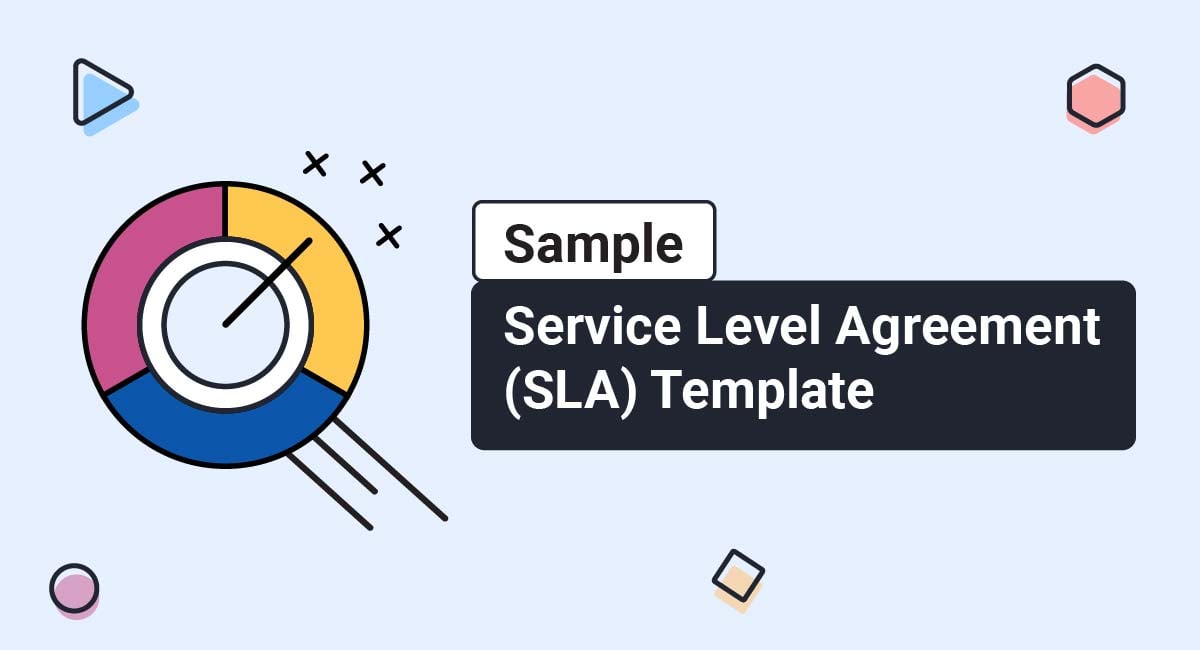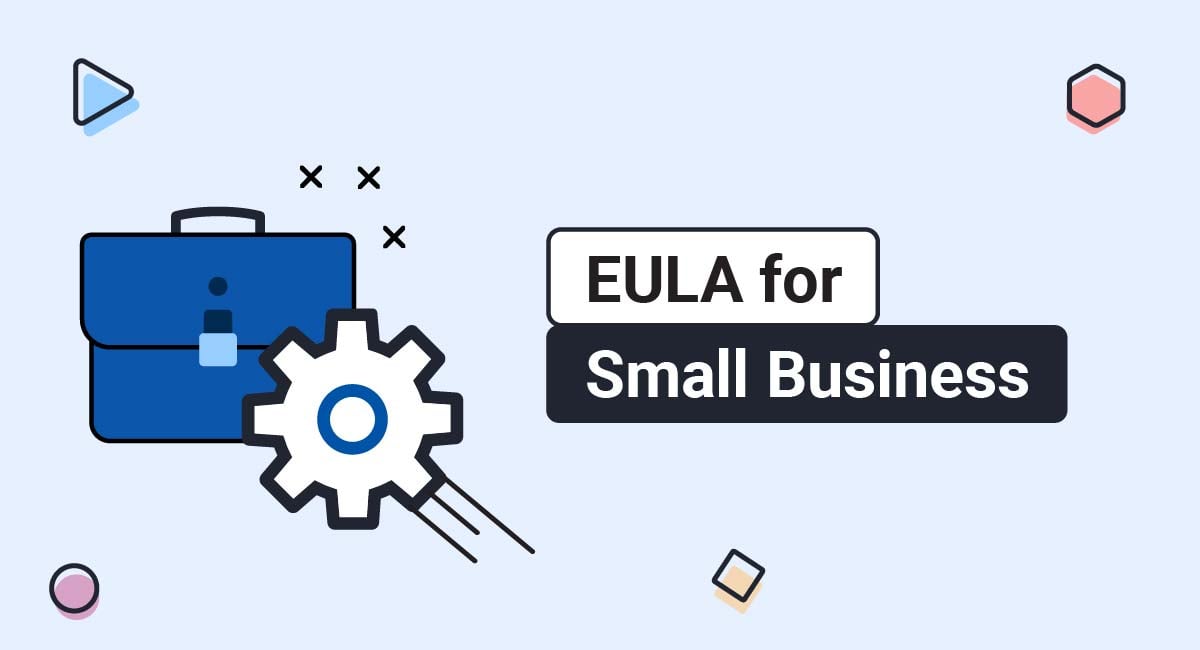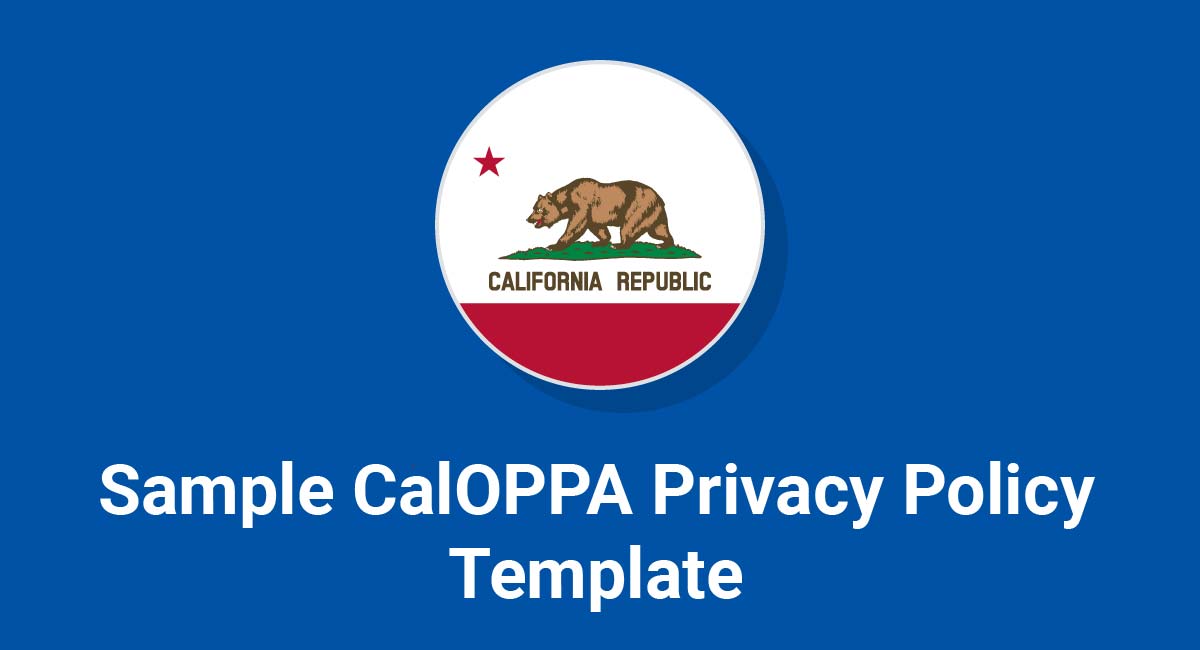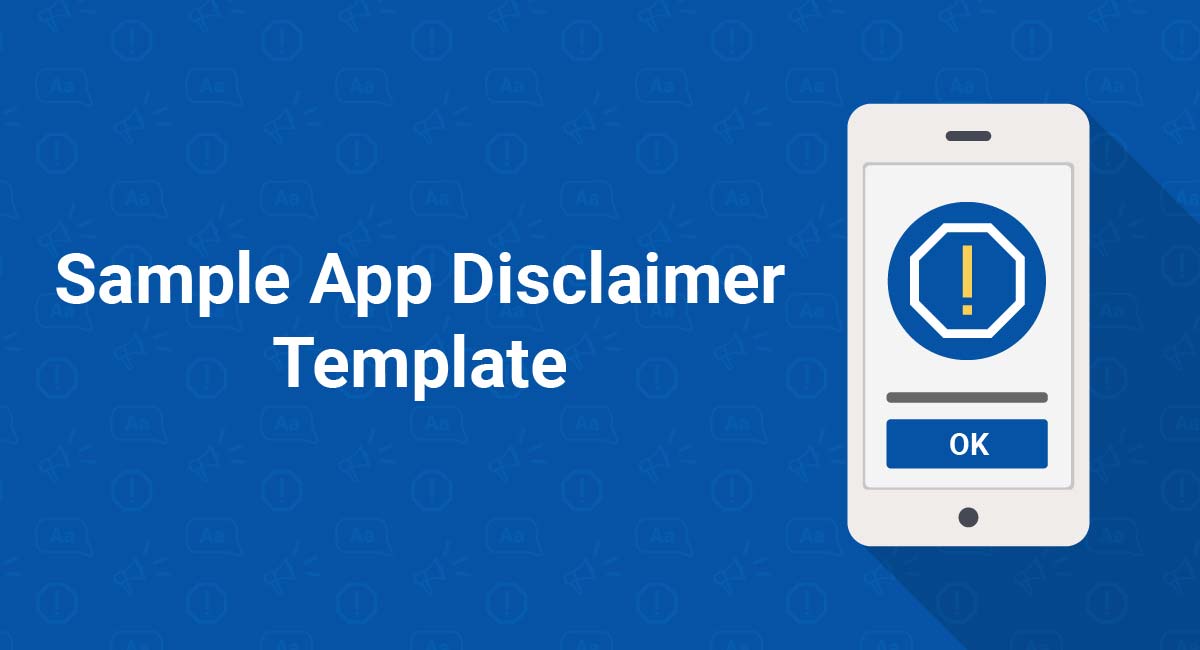A Service Level Agreement (SLA) is where an organization sets out the minimum performance levels which they will deliver. These agreements are often used in IT services, software as a service (SaaS), and other similar businesses where it is essential for both parties to know what is expected from each party.
Every tech business needs to have a Service Level Agreement in place to ensure all parties live up to their commitments, and it's just as important for customers to know what they're getting when they sign on for services with your company.
This article aims to discuss what a SaaS Service Level Agreement is, why you need one, what to include in one, and how you can use them to create better customer relationships.
We'll also provide examples and a template you can use when you're ready to create your own.
- 1. What's a Service Level Agreement?
- 1.1. Is a Service Level Agreement the Same as a Terms and Conditions Agreement?
- 2. Why Do You Need a Service Level Agreement?
- 2.1. Service Level Agreements Can Help Generate New Business
- 2.2. Service Level Agreements Create Clear Boundaries
- 2.3. Service Level Agreements Can Help You Retain Customers
- 3. Who Needs a Service Level Agreement?
- 4. Types of Service Level Agreements
- 4.1. Customer Service Level Agreement
- 4.2. Internal Service Level Agreement
- 4.3. Multilevel Service Level Agreement
- 5. What to Include in a Service Level Agreement
- 5.1. The Meaning of Downtime
- 5.2. Severity and Time-to-Respond
- 5.3. A Transparent Escalation Path
- 5.4. Penalties for Breaches
- 5.5. Exclusions
- 5.6. Reporting Requirements
- 5.7. Termination of Service
- 6. Summary
What's a Service Level Agreement?
As previously noted, a Service Level Agreement (SLA) is a service contract between two or more parties that specifies the levels of service, responsibilities, and liabilities to which a company and its vendors must adhere.
For example, Service Level Agreements outline specific criteria that a customer can expect the business to meet (i.e., uptime, responsiveness, etc.). This could mean that your servers will be available 99.9% of the time for your product or that customer service inquiries will all be answered within 24 hours.
Today, Service Level Agreements extend beyond IT, software, and SaaS companies, but they are so widespread that essentially all businesses within these industry verticals utilize them.
You can use one as a standalone document or as part of a larger contract.
A SaaS Service Level Agreement could include technical details as well as specific information on services and availability. Typically, they will also have metrics to measure service performance and penalties if a party doesn't meet its obligations under the agreement.
Here's an excerpt of a standard SLA table of contents so you can see the types of clauses addressed:
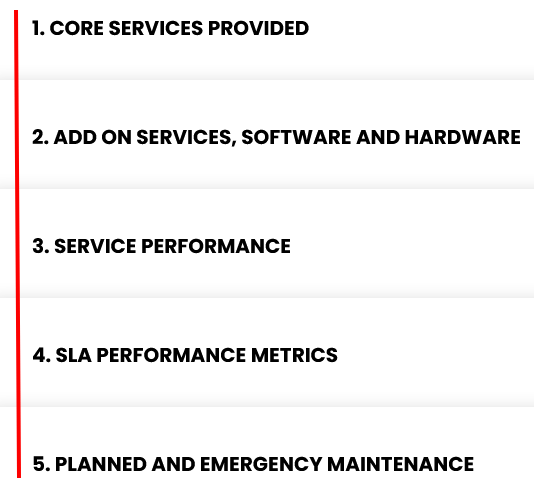
SLAs are usually part of outsourcing agreements or managed services agreements. Businesses can also use them in facilities management agreements or other agreements that provide services and can also be a relationship between one department and another within the company that provides a recurring service.
Is a Service Level Agreement the Same as a Terms and Conditions Agreement?
Service Level Agreements are different from a Terms and Conditions agreement (also known as a Terms of Service or Terms of Use agreement).
In short, a Service Level Agreement lets customers know what level of service they will receive, and what remedies exist if that level of service is not provided. SLAs are typically shorter in length and more narrow in scope than a Terms and Conditions agreement.
A Terms and Conditions agreement covers far more aspects of the business-customer relationship, including rules and restrictions for using the site or service, limitations of liability, how payments are processed, any warranties provided or disclaimed and other aspects of the relationship.
Here's an example of an excerpt of a Terms agreement from WhatsApp so you can see the types of clauses addressed and how they contrast with those in an SLA:
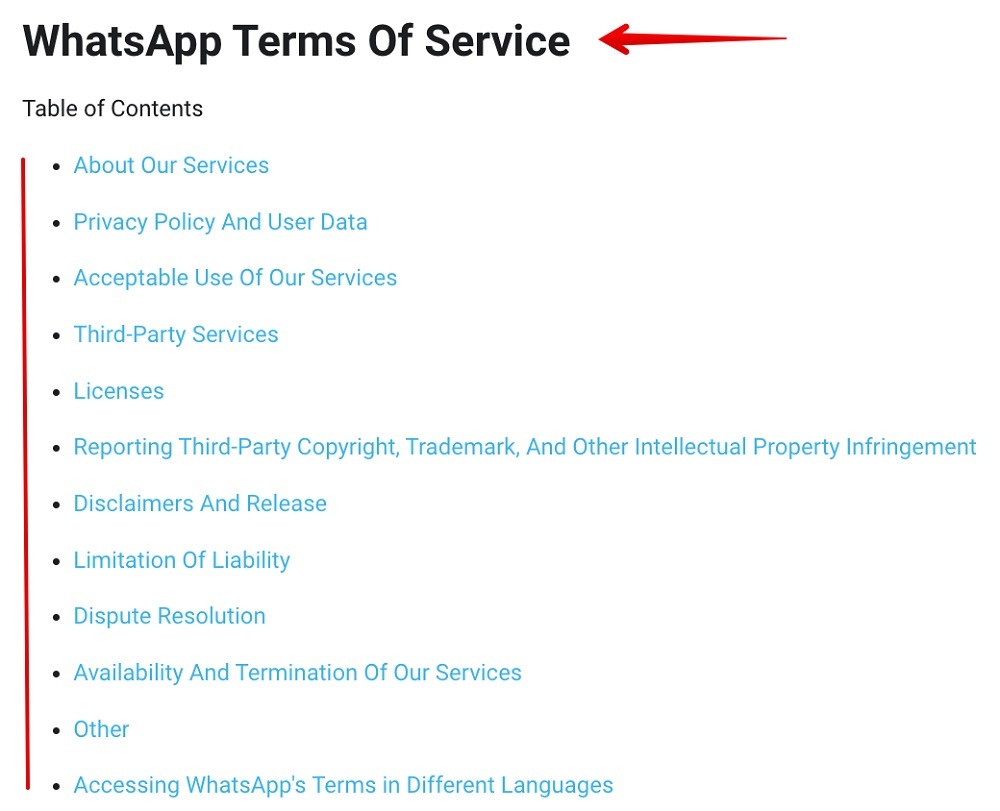
You will regularly see an SLA included as a sub-part of a Terms and Conditions agreement, but rarely if ever will you see it the other way around.
Why Do You Need a Service Level Agreement?
SLAs help strengthen customer relationships while helping customers manage their expectations realistically.
Remember that customers are aware of the risks associated with entering into new business relationships. Bad relationships can cause operational problems that negatively impact the bottom line of everyone concerned. A toxic business relationship can also damage the careers of any executives involved.
SaaS SLAs provide businesses with a safety net of accountability to ease these worries. SLAs ensure that customers are not forgotten once they sign the contract. For instance, the SaaS customer is assured that in the event of a service disruption, the SaaS vendor has the people and processes to fix the issue as quickly as possible.
They also provide the customer with recourse if the vendor doesn't meet its obligations, such as recovering lost revenue or ending the vendor relationship. In other words, SLAs mitigate the customer's risk and hold everyone accountable.
Service Level Agreements Can Help Generate New Business
Customers often leave a company when they feel their needs are not met. They look around, and the competitor that promises something better (and lives up to their promises) gets that customer's business.
With that in mind, you can leverage a business Service Level Agreement as an effective sales tool. A prospect who has had poor service delivery in the past can be affected by hearing about your SLA program's success and impact.
Service Level Agreements Create Clear Boundaries
Although Service Level Agreements can provide clear guidelines for employees to communicate effectively with customers, they are not only beneficial to one party. Employees can use a carefully crafted agreement as a resource for difficult conversations. Many companies have a customer service representative who is always available to answer questions and check on the status of an issue.
A Service Level Agreement can be a great document to help your employee reaffirm your communication guidelines in these circumstances.
For instance, your representative can refer to the SLA to let customers know you've agreed to give them a 12-hour response time for non-severe issues. A fact-based reminder usually causes the customer to back off, improving productivity and staff morale.
Service Level Agreements Can Help You Retain Customers
You can stand out from all other businesses by offering exceptional customer service backed up by a solid SaaS SLA. Your company should negotiate these agreements in advance to meet the customer's needs and ensure that they are fair for your business.
It is crucial to recall that each customer has similar relationships across industries when evaluating your business-customer relationship. This means that you are constantly being evaluated against your direct competitors and other customers.
Customer service excellence not only makes your business more successful but also lowers your churn rate while improving referrals.
Service Level Agreements, in short, are essential because they establish a formal communication process between a business' customers and its suppliers that allows both to be as efficient as possible.
Who Needs a Service Level Agreement?
Today, it's most common for businesses in the IT, software and SaaS industries to utilize these agreements, although other sectors have begun incorporating them as well.
Service Level Agreements originated in the late 1980s as a means through which IT companies could govern outsourced projects. The agreements set expectations for service providers' performance. In some cases, penalties were established for failing to meet the targets. Sometimes, bonuses were given for exceeding them.
Types of Service Level Agreements
The three types of Service Level Agreements are:
- Customer Service Level Agreement
- Internal Service Level Agreement
- Multilevel Service Level Agreement
Customer Service Level Agreement
A customer Service Level Agreement means exactly what it sounds like. It is an agreement between a vendor and a customer to provide a specific level of service.
The contract details the service type and quality that have been agreed upon. A telecommunications service may include voice calls, messaging, and internet services. However, they all exist under one contract.
Internal Service Level Agreement
An internal Service Level Agreement is only for parties within the company. It does not apply to customers.
A business may have a Service Level Agreement with all of its clients. However, it could also have a separate SLA between the sales and marketing departments, for example.
Multilevel Service Level Agreement
Multilevel Service Level Agreements come in many forms. You can use this agreement to support customers and your business's internal departments. This type of SLA defines what each party should do if more than one service provider or end-user is involved.
Additionally, it covers contracts at the following levels:
- Corporate level: Because the issues of this SLA are not subject to frequent changes, they do not need to be updated often. This agreement includes a discussion of all relevant aspects and is applicable to all customers of the end-user organization.
- Customer level: This contract covers all services related to a particular group of customers. It does not consider the type of user services. For instance, an organization might request that the security level in one of its departments be increased. In this instance, one security agency may secure the entire company, but it must provide additional security for that single department.
- Service level: This agreement includes all aspects that can be attributed to a specific service in relation to a customer group.
What to Include in a Service Level Agreement
A Service Level Agreement covers many practical issues. For example, it addresses what happens if the service is interrupted or if a customer can request a refund. Security and whether data is available after termination of service are two other subjects which are often covered.
You should consider all of these critical matters to cover in your SLA because you want to make sure that all parties are crystal clear about what they're getting out of the agreement. Some SaaS companies go a step further and provide all parties with the chance to negotiate terms.
With that said, here are seven elements common to most SaaS Customer Service Level Agreements.
The Meaning of Downtime
An important term to define within your SLA is "downtime."
A percentage often indicates guaranteed uptime. Of course, to the layperson, that can be confusing. However, you can use an uptime calculator to help put days, hours, and minutes into a quantifiable number.
During negotiations, some customers may want to press for a greater guarantee of uptime. Many SaaS companies are happy to provide that, but at a higher cost for the higher level of service.
Here's how Microsoft Azure Cognitive Services includes information about its uptime calculation as well as how service credits will work depending on any lack of uptime (aka downtime):
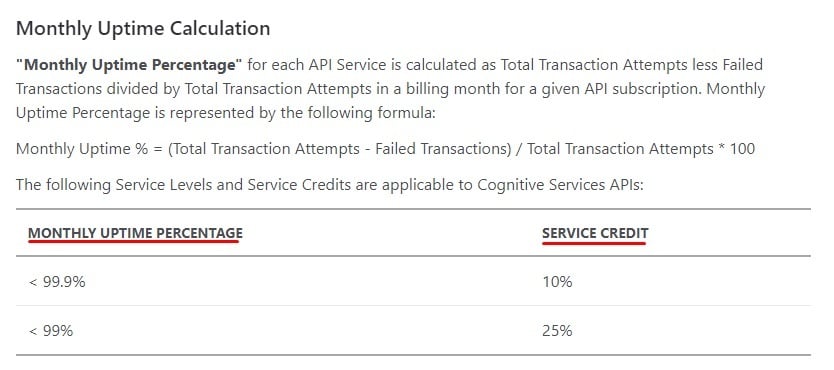
Cloudflare claims it will have a 100% uptime, but if it by chance doesn't, it offers a financial remedy to users:

If there is any downtime, Cloudflare has a formula for calculating a service credit it will offer:

Severity and Time-to-Respond
Not every problem is a major crisis that you must handle right away. On the other hand, some are. A good SLA should have a section which defines the severity of each problem and how long the company typically takes to resolve them.
For instance, Adobe lets its customers know the criteria upon which it bases its response times like this:
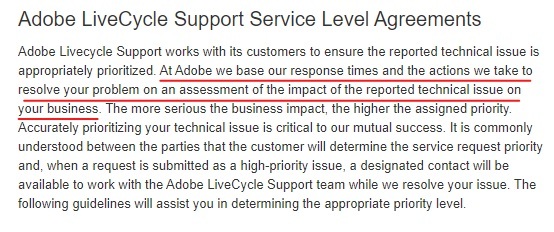
You can also choose to base your time-to-respond on priority. For instance, perhaps your customer prefers for c-suite issues to be resolved first. That's something, which you can specify in the time-to-respond section of your SLA.
Here's how Adobe lists the order of priority levels to which it will respond:
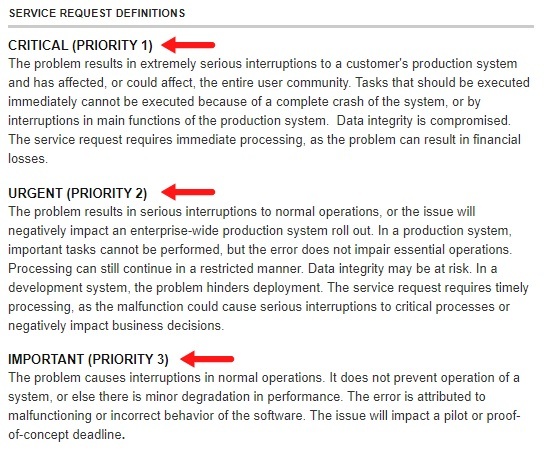
A Transparent Escalation Path
There must be a transparent chain of individuals with whom the SaaS purchaser can communicate if there are issues concerning your SLA. Therefore, you need a section of your SLA that lays out who those individuals are and how the purchaser can interact with them.
By way of example, suppose that your company has one individual who deals with support for low priority issues, while another puts out "immediate fires," as it were. Perhaps a manager or other executive needs to be involved "right now."
Here's how CloudCall outlines its escalation process:
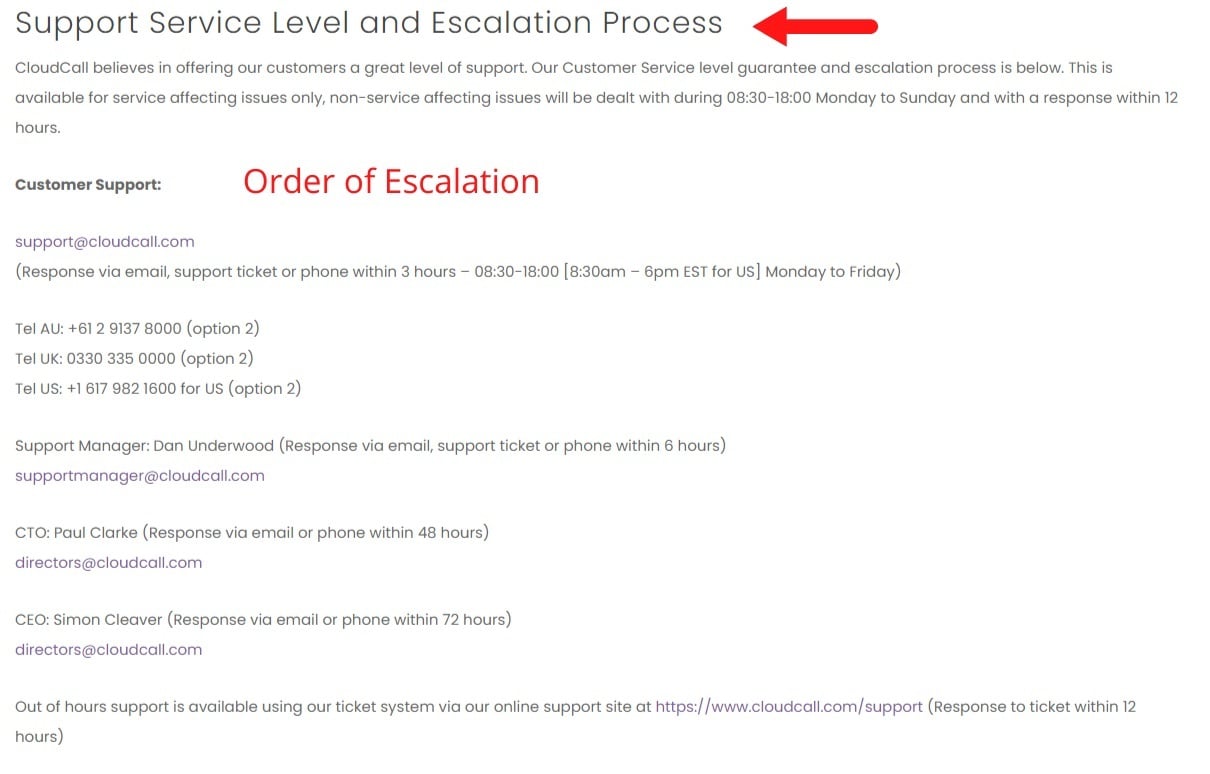
Your SLA should define what types of issues trigger escalation to someone higher up the food chain in your business. These definitions are often called escalation points.
Penalties for Breaches
Most legal agreements have a section that outlines what happens when a party violates its terms. In this respect, Service Level Agreements aren't any different.
SaaS Service Level Agreement penalties can include various "fines" on the company, such as the need for you to provide the purchaser with credits that give them free usage of your platform for a specified length of time.
You can see the way Proofpoint outlines how the company reimburses its customers for validated claims in the screenshot below:

Note that many SaaS customers look at SLAs to see whether there's a substantial amount of credits provided for issues related to downtime. If you're able to provide significant credit, it can provide your customers a sense of confidence in your ability to meet your uptime requirements.
Exclusions
If you're smart, you'll use the section on exclusions to your advantage. By using the section on exclusions shrewdly, you can remove penalties in some cases or specify precisely under which circumstances penalties apply. Having an experienced SaaS legal advisor can help substantially in this area.
Here's how Proofpoint addresses exclusions:

In the screenshot above, pay attention to how the customer is denied any remedies if they use the SaaS service outside of the uses agreed upon in the agreement.
Reporting Requirements
Reporting requirements are essential for mutual understanding and evidence should the need arise. They allow the SaaS purchasers to understand and hold the SaaS company accountable for metrics such as uptime, downtime, and performance. These reports are usually provided on a weekly or monthly basis. They should be discussed in regular SLA meetings.
CloudCall specifies that its reporting is done monthly by a third party and informs users how they can request a copy of the report at any time:

Termination of Service
You should put in a termination clause in every Service Level Agreement. This allows both the users and your company to terminate the agreement. These clauses can often be divided into termination with cause or without cause.
Termination with cause is when one party has violated the agreement to the extent that it gives the other party a legitimate, legal "out" of the agreement.
This is how CloudCall lays out what "with cause" means in its section on termination:

A termination without cause simply means that a party wishes to end the agreement despite the other party having done nothing wrong.
To put it plainly, there are some instances when a party is justified in ending the agreement, and no penalties are levied against it for doing so. On the other hand, if a party leaves without cause, then the party wishing to exit the agreement must typically provide some sort of compensation to the other party before the term of service expires.
Summary
A SaaS service level agreement (SLA) is a document that outlines the agreement and plan between your company and your customers in case something goes wrong with your service.
Every SaaS company should have a Service Level Agreement in place to protect its customers and ensure it lives up to its promises.
SaaS SLAs offer purchasers a safety net and accountability that eases their concerns. They ensure that customers aren't forgotten after they sign the contract. With a Service Level Agreement in place, you may assure your customers that in case of service disruptions, you'll have the resources and processes in place to resolve the problem as quickly as possible.

Comprehensive compliance starts with a Privacy Policy.
Comply with the law with our agreements, policies, and consent banners. Everything is included.
